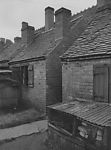 Domestic chain shop
Domestic chain shop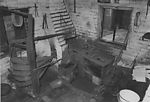 Interior of domestic chain shop
Interior of domestic chain shop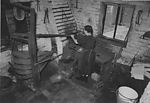 Heating the rod
Heating the rod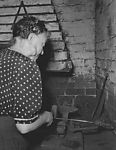 Cutting to length
Cutting to length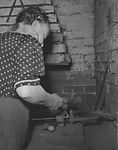 Bending in swedge
Bending in swedge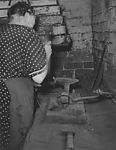 Laying or turning over on bick-iron (anvil)
Laying or turning over on bick-iron (anvil)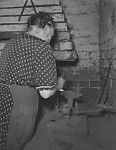 Welding
Welding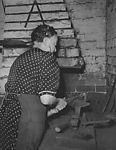 Twisting
Twisting A. Ewart Chapman painting.
A. Ewart Chapman painting.

Light chain was mostly made at home in small domestic workshops. The tools were simple and the chain made was up to 3/8in (10mm) in diameter, mainly for farm use, and was known as “countrywork”.
The images show us Elizabeth Jennings working at her anvil, a job she began when she was thirteen.
The workshop would have contained a small breeze (coke) fired hearth, hand bellows and hand tools consisting of a small anvil, a "swedge" for bending the iron rod, a "hardy" for cutting the rod to length, a "twister", tongs, two hammers and a water "bosh" for cooling the ironwork.
The end of a 10 ft (3m) length of rod was placed in the fire to bring it up to red heat. A child was often used to operate the bellows, or as it was known, the blast. The end of the rod was then nearly cut through to the length needed for the link. The short piece of rod, still connected to the main length by a thin piece of metal, was then bent around to form the rough link.
The rough link, in the form of a letter “U”, was broken off the rod by a twist of the hand, and threaded through the previous link. The ends were then "scarfed", or flattened, and laid over each other. The end of the link was then raised to welding heat in the fire and welded on the anvil using a hammer.
If the chain was to lay flat, like for an animal harness so that it was comfortable for the animal, the end of the hot link was placed in the bender and twisted.
If the chain needed to be smooth the hammer marks were smoothed out using a dolly. This is a tool which is shaped like the rod and placed over the welded link while still hot. The dolly is then hammered, which smooths out all trace of the hammer marks.
Many types of chain were made in this way, the manufacturer Samual Lewis & Co. listing over 140 types in its catalogue.
Rollover the captions in the box to see the available images in thumbnail format, click the caption to see the full-size image
| Reference: | 671 |
| Keywords: | |
| Archive Ref: | K. Gale Lib 1994/013/1250 |
| Updated: | Wed 21 Mar 2007 - 1 |
| Interpretation written by | Louis Howe |
| Author's organisation | Curatorial |
| Organisation's website |